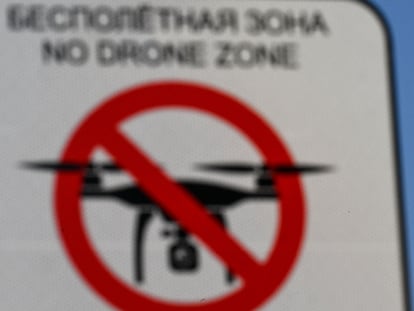EU fears Russia will use Kremlin drone attack for escalation of Ukraine war
Diplomats and analysts believe Moscow will capitalize on the incident to inflame anti-Western rhetoric. Deputy chairman of the Security Council of Russia, Dmitry Medvedev, has called for the ‘elimination of Zelenskiy and his clique’


The two blasts were small, but powerful in symbolism and the geopolitical context: two drones over the Kremlin, which Russian authorities claim were an attempt on the life of President Vladimir Putin. Moscow first blamed Kyiv, and then Washington, for the alleged attack last Wednesday. Both have strongly denied involvement and there is no evidence to suggest who was behind what happened, or exactly what happened in the first place. While intelligence sources stress that it is too early to determine, analysts and diplomats are divided on whether it was a false flag operation orchestrated by Russia to fuel anti-Western sentiment, an attack by Kyiv, or by anti-war partisan groups. At a time when a Ukrainian counter-offensive is widely expected and the Kremlin is also moving its troops on the frontlines — against the backdrop of Russia’s deepening perception of the impact of its war in Ukraine — there is one shared conclusion: the fear that Moscow will use the drone incident to launch a fresh offensive in Ukraine.
A Western diplomat formerly stationed in Russia believes that the attack is “yet another maneuver” by Moscow to inflame its rhetoric about the Kyiv government and that it will use it as a cover for another escalation of the war, with renewed attacks in Ukraine against political and civilian targets. The Kremlin will also take advantage of the excuse to further armor itself and stage another repressive barrage against its own citizens, while preparing the ground for a new mobilization, he adds. For the time being, although Russian state broadcasters have not made much mention of the drone attack, the deputy chairman of the Security Council of Russia, Dmitry Medvedev, has called for the “elimination of [Volodymyr] Zelenskiy and his clique.”
These are particularly sensitive days for the Kremlin on the eve of the commemoration of the Red Army’s victory over the Nazis — Victory Day — which Russia usually celebrates with great pomp and ceremony on May 9, but which this year has generated a heightened sense of fear and paranoia. Moscow authorities have banned the use of drones throughout the city, deployed new equipment to monitor the skies and GPS jammers, placed anti-aircraft batteries on government buildings and encouraged private firms to deploy their own drone defenses.
However, other European sources argue that as the Kremlin has not come out of the drone attack in the best of lights, it seems implausible that it was behind it. Experts such as Mark Galeotti and Anton Barbashin of independent analysis organization Riddle Russia argue that rather than a false flag operation, it was the work of Ukrainian or pro-Ukrainian groups.
The drone incident comes after other events that have shaken the Kremlin, and for which authorship also remains unclear, including the murder last August of Darya Dugina, daughter of the ultranationalist Aleksander Dugin, for which Russia blames Ukraine; the murder on April 2 of the military blogger Vladlen Tatarsky; or the attack last Saturday on the pro-war writer Zakhar Prilepin. All three events were very similar in terms of the targets and, to a certain extent, in terms of the method used.
There has also been a spate of recent sabotage attacks on trains, recruiting centers, airfields, fuel depots, and factories that analysts suggest could be a mixture of the work of Ukrainian secret services and Russian opposition groups, which have been receiving more help from overseas. On Sunday, Russian authorities claimed to have foiled a drone attack on a military airfield in the center of the country.

What the drone attack did achieve was to expose vulnerabilities in the heart of the Russian capital, while causing significant embarrassment for Russian air defenses and the Kremlin’s own protective screen, which is handled by the SVR, the intelligence agency in charge of protecting Putin and other members of the Moscow elite. It is unclear from the available footage whether the drones exploded or were shot down over the Kremlin. “Whichever it is, Moscow is going to capitalize on it,” says a senior EU source.
In Ukraine, the pro-Moscow authorities installed in the occupied territories of the Zaporizhzhia region have ordered the civilian population of several villages to evacuate, although Ukrainian intelligence sources point out that this is due more to preparations for the counteroffensive being prepared by Kyiv than as a reaction to the drone incident.
Meanwhile, NATO has warned that Russia, which is scanning the critical infrastructure systems of Atlantic Alliance member states, may be planning attacks on undersea cables essential for telecommunications and gas supplies. The risk is “significant,” NATO’s assistant secretary general for intelligence and security, David Cattler, said. Moscow is stepping up patrols in the Atlantic Ocean, in the North Sea and around the Baltic, and the alliance is putting increasing effort into a coordination center set up in February to protect critical undersea infrastructure and to which it has now assigned more surveillance ships.
Sign up for our weekly newsletter to get more English-language news coverage from EL PAÍS USA Edition
Tu suscripción se está usando en otro dispositivo
¿Quieres añadir otro usuario a tu suscripción?
Si continúas leyendo en este dispositivo, no se podrá leer en el otro.
FlechaTu suscripción se está usando en otro dispositivo y solo puedes acceder a EL PAÍS desde un dispositivo a la vez.
Si quieres compartir tu cuenta, cambia tu suscripción a la modalidad Premium, así podrás añadir otro usuario. Cada uno accederá con su propia cuenta de email, lo que os permitirá personalizar vuestra experiencia en EL PAÍS.
¿Tienes una suscripción de empresa? Accede aquí para contratar más cuentas.
En el caso de no saber quién está usando tu cuenta, te recomendamos cambiar tu contraseña aquí.
Si decides continuar compartiendo tu cuenta, este mensaje se mostrará en tu dispositivo y en el de la otra persona que está usando tu cuenta de forma indefinida, afectando a tu experiencia de lectura. Puedes consultar aquí los términos y condiciones de la suscripción digital.
More information
Archived In
Últimas noticias
Most viewed
- Reinhard Genzel, Nobel laureate in physics: ‘One-minute videos will never give you the truth’
- Oona Chaplin: ‘I told James Cameron that I was living in a treehouse and starting a permaculture project with a friend’
- Pablo Escobar’s hippos: A serious environmental problem, 40 years on
- Why we lost the habit of sleeping in two segments and how that changed our sense of time
- Chevy Chase, the beloved comedian who was a monster off camera: ‘Not everyone hated him, just the people who’ve worked with him’










































